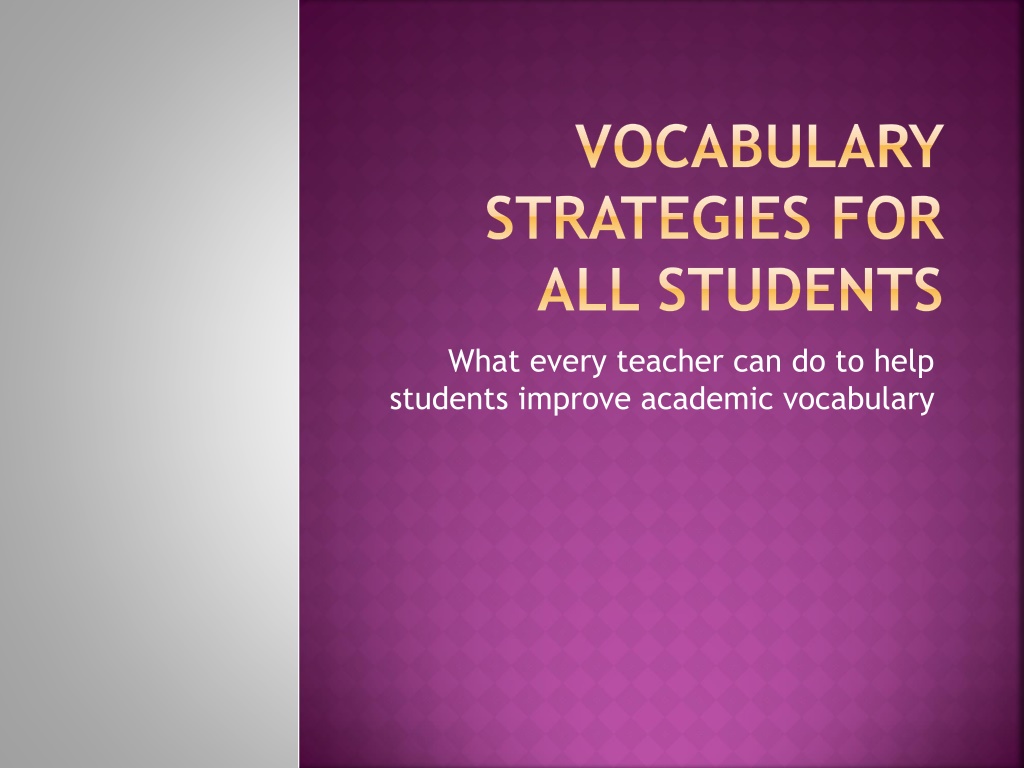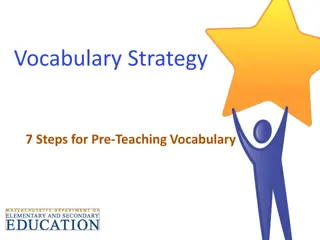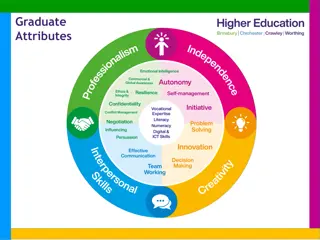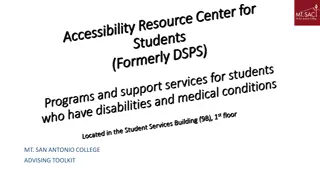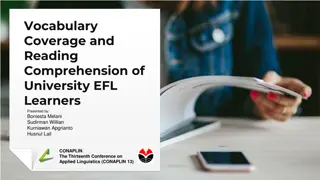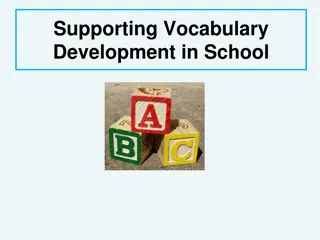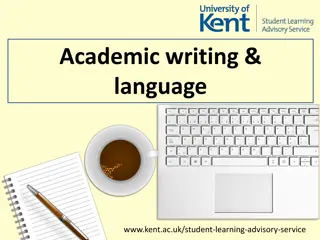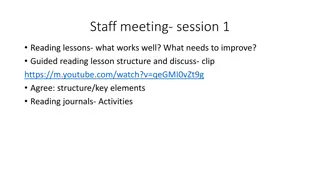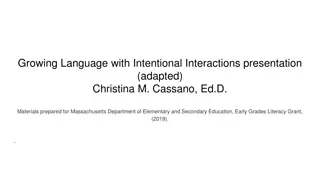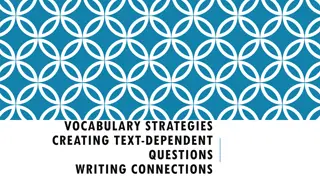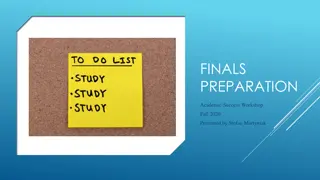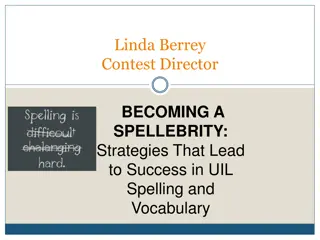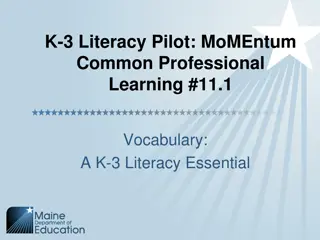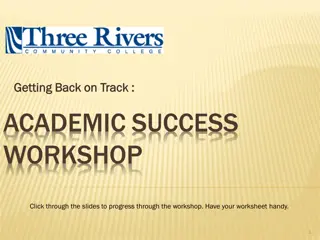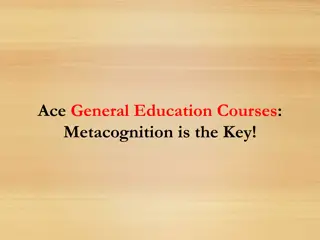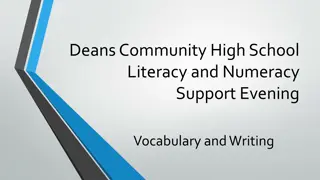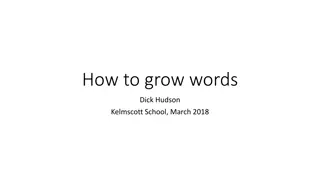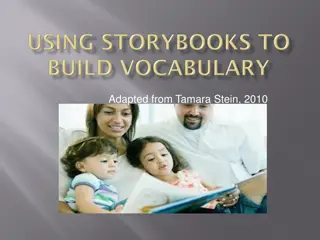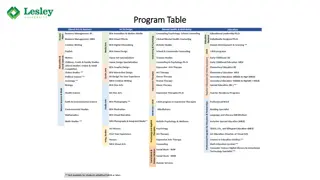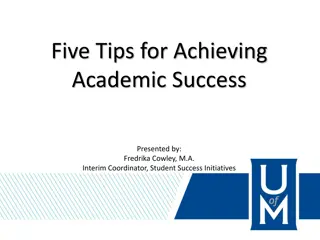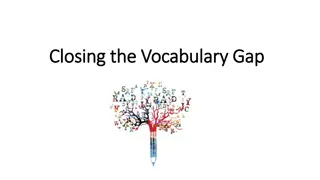Effective Vocabulary Strategies for Academic Success
This collection explores various strategies and research findings to enhance students' academic vocabulary, emphasizing the crucial role of vocabulary instruction in improving comprehension and background knowledge. It delves into the impact of direct vocabulary teaching on student performance and presents insights on language learning strategies and word acquisition rates. Discover practical tips and insights to support students in mastering vocabulary effectively.
Download Presentation

Please find below an Image/Link to download the presentation.
The content on the website is provided AS IS for your information and personal use only. It may not be sold, licensed, or shared on other websites without obtaining consent from the author.If you encounter any issues during the download, it is possible that the publisher has removed the file from their server.
You are allowed to download the files provided on this website for personal or commercial use, subject to the condition that they are used lawfully. All files are the property of their respective owners.
The content on the website is provided AS IS for your information and personal use only. It may not be sold, licensed, or shared on other websites without obtaining consent from the author.
E N D
Presentation Transcript
VOCABULARY STRATEGIES FOR ALL STUDENTS What every teacher can do to help students improve academic vocabulary
VOCABULARY INSTRUCTION Research shows a student in the 50th percentile in terms of ability to comprehend the subject matter taught in school, with no direct vocabulary instruction, scores in the 50th percentile ranking.
VOCABULARY INSTRUCTION The same student, after specific content-area terms have been taught, raises his/her comprehension ability to the 83rd percentile.
CONSIDER THIS Background knowledge is more important to the understanding of reading than IQ.
CONSIDER THIS Vocabulary instruction in specific content-area terms builds up student s background knowledge in content area
VOCABULARY INSTRUCTION It is not necessary for all vocabulary terms to be directly taught. Yet, direct instruction of vocabulary has been proven to make an impact.
OXFORD CLASSIFICATION OF LLS (1990) Language Learning Strategies Direct Instruction Indirect Instruction Memory Strategies Cognitive Strategies Compensation Strategies Metacognitive Strategies Affective Strategies Social Strategies
NEW WORDS PER DAY How many new words does a LEP or low SES student need to learn EACH DAY in order to catch up to a general education student?
NEW WORDS 17 words per day or 3000 words per school year
OWNING IT! How many times must a student interact with a word before they own it?
OWNING IT! 24 times
SCHEMA Information is connected and retained in the brain through mental pathways that are linked to an individual s existing schema.
STRATEGIES Learning Strategies are special thoughts or behaviors that individuals use to help them comprehend, learn, or retain new information.
SELF REGULATING STRATEGIES Teaching students a variety self regulating strategies improves student learning and reading.
STAAR The expectation is Metacognition - not fact regurgitation More academic & content vocabulary Greater depth of science content More thinking steps Must look for best, worst, NOT, etc.
METACOGNITION We must help our student think about their thinking We must directly teach them how to do this ALL teachers need to know and use these techniques
THINK ABOUT YOUR CLASS Picture a class or a group that you gave a task to but they felt unprepared for it Picture individual students within the class or group Now think What were they doing when you asked them to do something that they don t know how to do or have never experienced before? What did they say (word for word in quotes)? How do you think they were feeling? How were they acting?
THINK ABOUT YOUR STUDENTS Doing Saying My students Feeling Acting
VOCABULARY STRATEGIES Vocabulary strategies are good for all students: LEP , Low SES, students in the Special Education program, GT, general education Compiled from several conferences presented by Region 10 Researched based
WHERE DO I START? Polysemous Words What??? Words with multiple meanings These words must be taught explicitly They cross content areas, even Fine Arts These words cause breakdowns in understanding on standardized tests
EXAMPLES The judge asked the defendant to approach the bar. The man sat in the restaurant s bar. He bought a bar of soap.
EXAMPLES Mary walked along the bank of the river. Harbor Bank is the richest bank in the city.
POLYSEMOUS WORDS How many meanings can you come up with for the word: Measure
SOCIAL STUDIES- MEASURE The judge ruled using the full measure of the law.
ART VOCABULARY The museum s Impressionist exhibit didn t measure up to last year s.
ACTIVITIES VS. STRATEGIES Activities don t encourage Metacognition Strategies are: Taught at a very young age Perfected throughout rest of your life Applicable across the curriculum and contents Looking for patterns Graphing Using roots, prefixes, & suffixes
PREFIXES Prefix Meaning % of All Example Prefixed Words un-, re-, in- (not) account for 51% of total un not; reversal of 26 uncover re again, back, really 14 review in / im in, into, not 11 insert un-, re-, in- (not), dis- account for 58% of total dis away, apart, negative 7 discover en / em in; within; on 4 entail mis wrong 3 mistaken pre before 3 prevent a not; in, on; without 1 atypical
SUFFIXES -s, -es, & -ing account for 65% of suffixed words Suffix Meaning % of All Suffixed Words Example 31 -s, -es more than one; verb marker in the past; quality, state when you do something; quality, state how something is one who, what, that, which state, quality; act able to be related to, like characters, reads, reaches 10 suffixes account for 85% of suffixed words: -s, -es, -ing, -er, -ion, -able, -al, -y, -ness, & -ly -ed 20 walked -ing 14 walking -ly -er, -or 7 4 safely drummer -tion, -sion -able, -ible -al, -ial 4 2 1 action, mission disposable, reversible final, partial
STRATEGY #1 Objectives Content You are already doing these well! Language based on the ELPS Reading Writing Speaking Listening
STRATEGY #2 Use sentence frames to scaffold students use of academic vocabulary: Plants use ________ to make food. ________is the process by which plants make _______from light, water, nutrients, and carbon dioxide. This gives them confidence to answer questions when they otherwise wouldn t. Post generic frames around room for students to use.
STRATEGY #3 Use analogy sentence frame for the academic word: Example: The word ____ is related to ______ when The word measure is related to music when The word measure is related to science when
STRATEGY #3 CONT. Older students can do more in depth analogies with a relating factor: _____ is to ______ and ______ is to ______. Relating Factor: ____________ EX: Bird is to fly as fish is to _____ Relating Factor: mode of transportation
STRATEGY #4 Word Meaning #1 Meaning #2 Musical symbols that tell me what to play on my instrument Writing down what the teacher says in my notebook so I can study it later notes A color produced by adding black to a pigment A piece of fabric you pull down over the window or put in your windshield to block out the sun Shade The time established for the actors to report to the theater before a performance When I say my dog s name because I want him to come to me Call
STRATEGY #5 - 4 FOLD VOCABULARY In this activity, students fold their papers into rows of 4 sections each. The number of row can relate to the number of words to be studied. In the first section, the student writes the word. In the 2nd section, the student writes a definition of the word in their own words. In the 3rd section, the student draws a picture or symbol to represent the word. In the 4th section, the student writes a sentence with the word based on their definition. Students fold the paper and keep as notes. Word Definition Picture Sentence beat a steady succession of rhythm The beat of music is measured in BPM.
STRATEGY #5 What do you see? Show a picture of the word or concept you are teaching Cover or more of the picture Ask students to use their vocabulary to describe what they think the picture is
COGNITIVE DICTIONARY Introduce new vocabulary Done with only the most academic demanding words ELPS learning strategy Done over two days for best learning Metacognitive strategy helps students think about their thinking
Do these on day two Do these on day one Word Prediction Ask each groups to tell you their predictions write all their predictions in this column Meaning/Sketch After the lesson, have groups decide on a definition and draw a visual representation Sentence Add the sentence each group writes using the word, sentence should contain context clues to define the word Give them a word that is used in your content area ask them to predict what the word means without looking the word up then After each group makes a prediction ask them HOW they got their prediction, i.e., knew the suffix, same root as another word, knew the word in Spanish, etc. Help them put it in academic terms and write it down. Strategies 1) 2) 3) 4) 5) Keep these posted in your class and refer back to them to help students think about their thinking! Strategies need to be applied across the curriculum.
MULTIPLE REPRESENTATIONS 1. Teacher tells students what the word means. 2. Teacher draws a picture or symbol for the word. 3. Student uses own words to tell what the word means. 4. Student draws or shows his/her own picture or symbol for the word. 5. Student makes connections to the word in writing or orally. 6. Student shares the word with others.
STRATEGY #6 Pictionary with a twist Give student the target word Student draws a picture to elicit the word BUT the student is explaining the picture they are drawing using academic vocabulary The class tries to guess the word Students are practicing using academic vocabulary in a safe environment
STRATEGY # Marzano s Building Academic Vocabulary Students restate description in their own words Describe the term in kid friendly language Students construct a picture MOST important step, a symbol only that means something to them Students engage the word through an activity: take word apart, look for root, etc Play games with words Discuss terms with each other tell how the word is relevant in their own lives THE KEY: REPETITION
